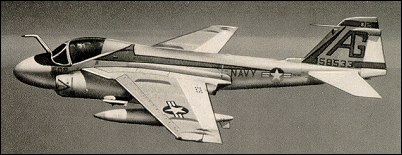|
| The first prototype flew on April 19, 1960. A total of 482 were built.

| CREW | 2 |
| ENGINE | 2 x P+W J-52-P-8A, 41.3kN |
| WEIGHTS |
| Take-off weight | 27500 kg | 60627 lb |
| DIMENSIONS |
| Wingspan | 16.2 m | 53 ft 2 in |
| Length | 16.3 m | 54 ft 6 in |
| Wing area | 49.2 m2 | 529.58 sq ft |
| PERFORMANCE |
| Max. speed | 1000 km/h | 621 mph |
| Cruise speed | 770 km/h | 478 mph |
| Ceiling | 12700 m | 41650 ft |
| Range w/max.fuel | 5000 km | 3107 miles |
 | A three-view drawing (1000 x 553) |
| Jack Sullivan, e-mail, 16.04.2008 19:50 The only jet that could replace the AD on the Carrier. In performance it has to be considered one of the best we ever produced. Nothing has taken it's place as yet. reply | | Joe Brewer, e-mail, 03.04.2008 04:51 There was also a 2 seat electronics variant, the EA-6A as well as the A-6B SAM Superission Variant and of course the KA-6D Tanker version.
You have a great website.. Thanks.. Joe reply | | Jeff Kutz, e-mail, 21.08.2007 07:38 The two crew members were positioned in side-by-side seating. There was also an electronics warfare variant that had four crew members, the two extra seats added behind the two original seats. This plane was notable for the gold-colored shine that could be seen in the canopy glass. The story was that the glass was coated with a thin gold layer to protect the crew from the radio emissions of the electronic warfare equipment. reply |
|
Do you have any comments?
|
| 
COMPANY
PROFILE
All the World's Rotorcraft
|













